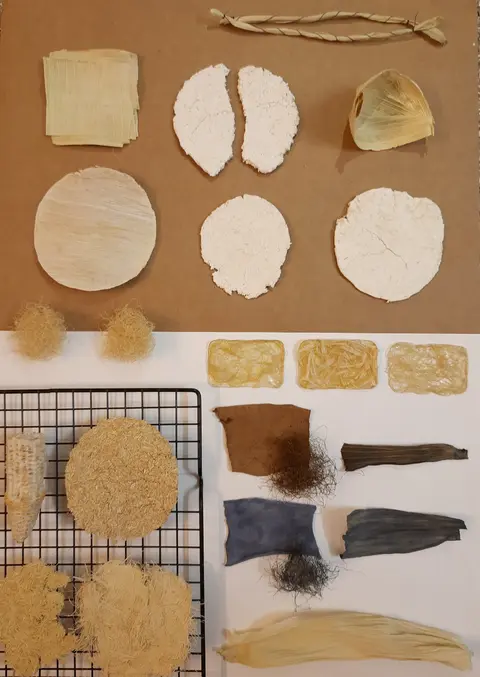Prayog Collective
SELECT WORK
-
Grassland Crafted
-
Bubble
-
Kagaz
-
Makerspace for biomaterials
MATERIALS
-
Paper
-
Grass
-
Mango Peel
-
Kombucha
-
Mycelium
-
Orange Peel
-
Onion
-
String Algae
-
Textile Waste
About
Services
info@prayogcollective.com
Instagram
©2025 PrayogCollective
Makerspace for biomaterials, a 2 week curriculum design
Open Elective 2022 (National Institute of Design Ahmedabad)
Open electives is a module offered By NID to the design student of masters 2nd semester and bachelors 4th semester together. This years the electives focused on “Play paradigms” where we offered a two week of material making course and its implications in plausible hypothetical scenarios. The objective of the workshop was to enable students to research, inquire, experiment, and play with natural organic materials. The methodology is focused on learning by doing and reflecting on the progress, eventually understanding the behaviour of materials. The workshop also shed light upon the implication of design tools and critical thinking, using which speculating the future of materials and its usage in the system.
PREFACE
Our material journey began in year 2020, during the covid lockdown. The first feat was winning a speculative design challenge by a de`tudio based in Mexico. The project got us intrigued about the possibilities of material innovation and moreover what inspired us was the sheer amount of people working in the field of material innovation and its futures. Many a times our discussions were about how to do similar things in India.
In the pursuit of possibly making a material & design studio while also applying for many competitions and residencies we landed on Precious plastics which is an open source organization based in Netherlands. The organization has worked on systems which ensures proper collection, segregation and recycling of waste plastic while also involving all the stakeholders. Taking inspiration from this we went on to developing our own system around waste management which is based on the Indian context.

Utilizing bio-waste to make innovative materials is a part of the over all system, under which we started material experiments at home. We started having little to zero knowledge about material science and material making. with time we got a little success and many failed experiments. The failures was never a setback but a learning which helped us get better at the overall process. We learned by doing, learning from the outcomes of the experiments and also reading about many processes, ingredients and frequent discussions about work going across the world.
OPPORTUNITY TO TEACH

PREPARATION FOR THE COURSE

The preparation for the course began a month back from the starting day. There were daily discussions on how to go about the course and what to teach, while we are also learning new things every day it becomes challenging on how much to explain and in what order adding to the fact that this is our first time teaching someone professionally and a sheer beginning of the field of material exploration in general.
Initially we thought of having a sort of having a tangible output based aim where the participants would be focusing on making a toy/object with their material explorations. But we were constrained by a short timeline of two weeks any material would still be in the process of attaining final form after solidifying. The students were devoid of the industrial/workshop facilities at their homes there was no way to fasten the process. After understanding our limitations and also realizing that instead of only giving only material understanding it would be better to give them understanding to other aspects of material as a whole, from its genesis, evolution,
present conditions towards what could be possible in our the probable future.
This included understanding how evolution has been defined by the materials humans have used throughout history. understanding culture and traditional/vernacular practices around making things. Learning by doing, making habits of collecting waste and using that to make many material samples. Understanding their role as designers and trying to understand the material industry and how the system works. Imagining probable scenarios of materials in the multiverse of digital and physical.
THE EXPERIENCE
Very similar to how the seats for our course got filled up, the actual course took off very rapidly in the second day itself, after we introduced a recepie to make a bio-plastic. We did some basic explorations with it and after that the students started doing many experiments and came up with a plethora of explorations by the end of first week. The first week was planned to be material intensive, with theory about material, culture and sustainability.
The whole course can be divided into three parts:
PAST
History of materials and humans, material evolution, native culture, vernacular practices
PRESENT
material trends, industry, material innovation & industry, circular economy, making culture
FUTURE
possibilities of product, service, system, sub-culture around materials and culture
The second week was brain heavy, it is where the participants understand their role as designers which is like a bridge between the industry and culture.
“You are living in the year 2060, the Metaverse and earth are the worlds we inhabit. People navigate between the both, and you have the choice to be in any one of those. The world around you has three types of materials, digital materials, old materials and bio-materials” A series of mindmaps based on the scenario above led to the genesis of design ideas which can see light in the probable future.
















